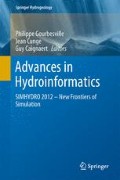Abstract
At early stage of a hydroelectric project, 1D transient simulations are performed to determine the basic layout of power plant. In this phase, the design of surge tanks is decisive to achieve good dynamic performances of the power plant, with respect to water hammer and mass oscillations induced by the hydraulic machines for normal, exceptional, and accidental operation. As the head losses between the gallery and the surge tank have strong influence on the transient behavior of the hydraulic system, they are usually optimized by means of 1D transient simulation to avoid low pressure in gallery or surge tank overflow. An asymmetric diaphragm is often placed at the surge tank inlet to achieve the optimum inlet and outlet head losses. Thus, the design of such diaphragm is a challenging task usually performed through an iterative process on reduced-scale model. In this context, 3D CFD simulations can significantly improve the design process to select the appropriate geometry of the diaphragm. In this chapter, head losses coefficients of a surge tank scale model are derived from CFD simulations performed with ANSYS CFX. Results are compared with measurements on reduced-scale physical model and analytical approach. The good agreement of CFD computations with measurements demonstrates that a design optimization with 3D flow simulations can be performed preliminary to scale model tests in order to reduce the number of geometries to be tested to achieve the expected head losses.
Access this chapter
Tax calculation will be finalised at checkout
Purchases are for personal use only
Abbreviations
- f :
-
Darcy- Weisbach loss coefficient, [–]
- g :
-
Gravitational acceleration, [m.s−2]
- \(\overrightarrow {n}\) :
-
Normal vector to surface, [–]
- p :
-
Pressure, [Pa]
- q :
-
Non-dimensional flow rate, [–]
- \(y^{ + }\) :
-
Y plus, [–]
- \(\Delta h_{{ij}}\) :
-
Non-dimensional head losse from i to j, [-]
- A :
-
Cross section area, [m2]
- \( \overrightarrow {C} \) :
-
Velocity vector [m.s−1]
- D :
-
Diameter, [m]
- \(H_{i} \) :
-
Total head, [m]
- \( K_{{ij}}\) :
-
Head loss coefficient, [–]
- L :
-
Length, [m]
- \( Pz_{i} \) :
-
Piezometric head, [m]
- Q :
-
Flow rate, [m3.s−1]
- Re :
-
Reynolds number, [–]
- \( \Delta H_{{ij}} \) :
-
Total head loss from i to j, [m]
- \( \alpha _{q} \) :
-
Relative flow rate, [–]
- \( \lambda \) :
-
Length scale, [–]
- \( \rho \) :
-
Density, [kg.m−3]
References
Stucky, A. (1958). Chambres d’équilibres. EPFL, Cours d’aménagement des chutes d’eau, Sciences et Technique.
Huber, B. (2009). Physical model tests and CFD simulation of an asymmetrical Throttle in a T-Shaped Junction of a High Head Power Plant. 33rd IAHR Congress: Water Engineering for a sustainable Environment, pp. 5013–5021.
Klasinc, R., Bilus, I. (2009). Experimental and numerical approach to surge tank improvements. international symposium on water management and hydraulic engineering.
Richter, W., Dobler, W., Knoblauch, H. (2012). Hydraulic and numerical modelling of an asymmetric orifice within a surge tank. 4th IAHR international symposium on hydraulic structures. Porto, Portugal.
Gabl, R., Achleitner, S., Neuner, J., Götsch, H., Aufleger, M. (2011). 3D numerical optimisation of an asymmetric orifice in the surge tank of a high head power plant. 34th IAHR world congress, Brisbane, Australia.
Huber, B. CFD simulation of a T-junction. Institute of hydraulic and water resources engineering, department of hydraulic engineering, Vienna University of Technology.
Basara, B., Grogger, H. A., Klasinc, R., Mayr, D. Experimental and numerical study of the flow through a trifurcation.
Steyrer, P. (1999). Economic surge tank design by sophisticated hydraulic throttling, proceedings of the 28th IAHR congress. Austria: Graz.
Nicolet, C. (2007). Hydroacoustic modelling and numerical simulation of unsteady operation of hydroelectric systems, Ph.D. Thesis, EPFL N 3751, Lausanne, (http://library.epfl.ch/theses/?nr=3751).
Thoma, D., (1910). Zur Theorie des Wasserschlosses bei selbsttätig geregelten Turbinenanlagen, Munich (Oldenbourg).
Gadel, A., Rechsteiner, G. D. (1970). Les pertes de charge dans les branchements en Té des conduites de section circulaire. Bulletin technique de la Suisse Romande, N 25, pp. 363–391.
Idel’cik, I. E. (1960). Memento des pertes de charges. Paris: Edition Eyrolles.
Acknowledgments
Authors would like to thank particularly Mr. Roberto Rosseti from CADFEM company who placed test license of ANSYS products at our disposal to check feasibility of such study.
Author information
Authors and Affiliations
Corresponding author
Editor information
Editors and Affiliations
Rights and permissions
Copyright information
© 2014 Springer Science+Business Media Singapore
About this chapter
Cite this chapter
Alligne, S., Rodic, P., Arpe, J., Mlacnik, J., Nicolet, C. (2014). Determination of Surge Tank Diaphragm Head Losses by CFD Simulations. In: Gourbesville, P., Cunge, J., Caignaert, G. (eds) Advances in Hydroinformatics. Springer Hydrogeology. Springer, Singapore. https://doi.org/10.1007/978-981-4451-42-0_27
Download citation
DOI: https://doi.org/10.1007/978-981-4451-42-0_27
Published:
Publisher Name: Springer, Singapore
Print ISBN: 978-981-4451-41-3
Online ISBN: 978-981-4451-42-0
eBook Packages: Earth and Environmental ScienceEarth and Environmental Science (R0)

